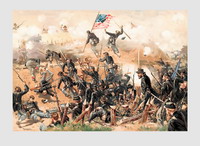Login form
Civil War

The Civil War divided the United States into two warring sides: North and South. It is sometimes called the War Between the States. The war lasted from 1861 to 1865. More than 600,000 soldiers died in the war. The war held the United States together and ended slavery in the nation.
A DIVIDED NATION
In the 1800s, the Northern states and Southern states were very different. The Northern states were industrial. Many European immigrants had settled in the North to work in factories. The Southern states focused more on farming.
Cotton and other crops were grown on large plantations in many parts of the South. Slaves from Africa tended the fields and picked the cotton.
Planters in the South owned nearly 4 million slaves. Northern states had outlawed slavery, and many Northerners believed that slavery should be outlawed in all states.
A CONTROVERSIAL PRESIDENT
When Abraham Lincoln was elected president in 1860, people in the South were angry. They knew Lincoln opposed slavery, and they saw him as a threat to the main source of labor for their plantations.
Even before Lincoln took office in March 1861, the state of South Carolina had seceded (broken away) from the United States. Six other cotton-growing states had soon followed South Carolina. They were Mississippi, Florida, Alabama, Georgia, Louisiana, and Texas. Later in 1861, four more states joined in seceding: Virginia, Arkansas, North Carolina, and Tennessee. These 11 states formed the Confederate States of America.
The Confederate States, or Confederacy, elected Jefferson Davis as their president. They picked Richmond, Virginia, as their capital.
The 22 states that remained in the United States were called the Union, or the North. Lincoln refused to recognize the Confederate States as separate from the rest of the country.
THE ATTACK ON FORT SUMTER
As Southern states seceded, they took control of federal forts within their boundaries. Lincoln said he intended to hold on to these forts. Union troops still occupied Fort Sumter in South Carolina.
Confederate general P. G. T. Beauregard asked the Union commander at Fort Sumter to surrender the fort. When the commander refused, Confederate cannons began firing at the fort. The Union commander surrendered two days later.
The attack on Fort Sumter outraged people in the North. President Lincoln called for 75,000 men to join the Union Army. He ordered a blockade (blocked entrance) of ports in the South.
THE FIRST BATTLES
The North expected a short war because it had many advantages over the South. The North, unlike the South, already had a national army and navy. The North also had more people, more factories, and more wealth. But the South shocked the North by winning the first battles.
THE SOUTH INVADES THE NORTH
Robert E. Lee of Virginia was the South’s best general. In September 1862, Lee led 50,000 Confederate soldiers on his first invasion of the North.
Lincoln sent 70,000 men to stop Lee. The two sides fought near Antietam, in western Maryland. The Union stopped Lee’s invasion of the North. But the Battle of Antietam was the bloodiest one-day battle of the war.
FREEING THE SLAVES
Lincoln issued the Emancipation Proclamation on January 1, 1863. The proclamation declared that slaves in the rebelling states were free.
The proclamation weakened the South and encouraged 180,000 African Americans, many of them former slaves, to join the Union Army.
BATTLE OF GETTYSBURG
Lee invaded the North a second time in June 1863. His army of 75,000 soldiers met 85,000 Union soldiers on July 1, near the Pennsylvania town of Gettysburg. They fought for three days before Lee retreated.
Congress made the battlefield a national cemetery. Lincoln gave his short but famous speech, the Gettysburg Address, at the cemetery.
LINCOLN SEARCHES FOR A GENERAL
The president appointed one general after another to lead the Union Army. But these generals didn’t prove capable of winning the war.
General Ulysses S. Grant won Lincoln’s confidence after he won an important battle at Vicksburg, Mississippi, in 1863. The victory gave the North control of the Mississippi River. This big river was an important route for steamboats carrying soldiers and supplies.
Lincoln appointed Grant to head the Union armies in March 1864.
GRANT ATTACKS
General Grant began aggressive attacks against the Confederacy. His army surrounded Petersburg, Virginia, just south of the Confederate capital of Richmond. He hoped to take control of Richmond and cut railroad links to the rest of the Confederacy.
Grant also sent General William Tecumseh Sherman and 60,000 soldiers to attack Atlanta, Georgia. After capturing that city, Sherman’s soldiers marched eastward to the Atlantic Ocean. They burned crops and tore up railroad tracks along the way. They wanted to destroy anything that might help the Confederate Army.
LEE SURRENDERS
General Lee surrendered to General Grant on April 9, 1865, at the village of Appomattox Court House in central Virginia. The war was over. The Union was preserved, but the division between North and South would take a long time to heal.
Source: Microsoft ® Encarta

